#Fallout meta
Explore tagged Tumblr posts
Text
i honestly think the ghoul believes lucy is just full of shit until she gives him those vials. like he does not believe she is genuinely that good of a person because no one is that good of a person anymore, and because she is the product of vault-tec middle-management. he is constantly expecting her to show her "true colors" (hence "there you are, you little killer" after she bites off his finger) until that moment when she chooses to help him despite the fact that he's done nothing to deserve her kindness. COMPELS ME!!!!
#fallout#fallout tv#fallout prime#fallout meta#fallout spoilers#cooper howard#lucy maclean#vaultghoul#ghoulcy#bee.txt#posted this on an rp blog and it keeps getting likes so !!!#here fandom have a rebloggable version#(if you want it)
4K notes
·
View notes
Text
people complain about long-term settlements in fallout being too ramshackle, and basically looking like they were just built despite the fact that the nuclear apocalypse happened 200 years ago. "people should be building proper, long-term structures and not just building shacks out of rubble at this point" is the argument i hear, applied to places like the new vegas strip or diamond city in fallout 4.
and i don't 100% disagree, but i do feel like this logic assumes that the bombs dropping 200 years ago is the only disruptive thing that's happened in these places? "the wasteland is a living place, people should be rebuilding and not just living in rubble" <- yes, but the wasteland is also a living place filled with constant power struggles and warring factions and regime changes. maybe that city isn't what they managed to build in the last 200 years since the bombs dropped, maybe it's what they managed to build in the last 30 years since the last time they got attacked by another place and almost wiped out.
it just doesn't seem that unrealistic to me, is all, especially if you've been to areas that have been afflicted by poverty and scarcity for hundreds and years and seen that these sorts of conditions do actually exist. humans persist under all sorts of harsh circumstances.
ETA: this post got a lot more attention than i expected, and people are taking it as some bethesda fallout vs non-bethesda fallout thing, which i don't get because i think all of the games are guilty of the "people living in 200 year rubble" thing that gets criticized so much. as i mentioned in the tags, this post was inspired by a cleanup mod for new vegas. and to be clear, i'm not saying that all the games necessarily execute this concept well, but it does make sense as a concept and isn't the gaping plothole a lot of people take it to be. like, look up what slums in the poorest countries in the world look like. imagine what what would happen to social norms in a world where everything blew up and you had to start over with practically no resources and no central government.
#mine#fallout#this thought inspired by this really well made mod i saw that replaces the walls around the strip with like#professional looking reinforced ones#and gets rid of all the rubble#which like. yeah i think the strip could have a BIT more cleaning up but still#fallout meta#fallout new vegas
409 notes
·
View notes
Text
One of my favourite specific tropes has got to be murder bride.




#unmatched#recs pls if u have them!!#blue eye samurai#mizu#fallout tv series#lucy maclean#kill bill#beatrix kiddo#ready or not#grace le domas#mizu blue eye samurai#the ronin and the bride#lucy fallout#fallout tv show#fallout tv spoilers#the bride#kill bill vol. 1#ready or not 2019#blue eye samurai meta#fallout meta#my stuff
713 notes
·
View notes
Text
Walton Goggins killed me with these comments re: Cooper seeing Janey again
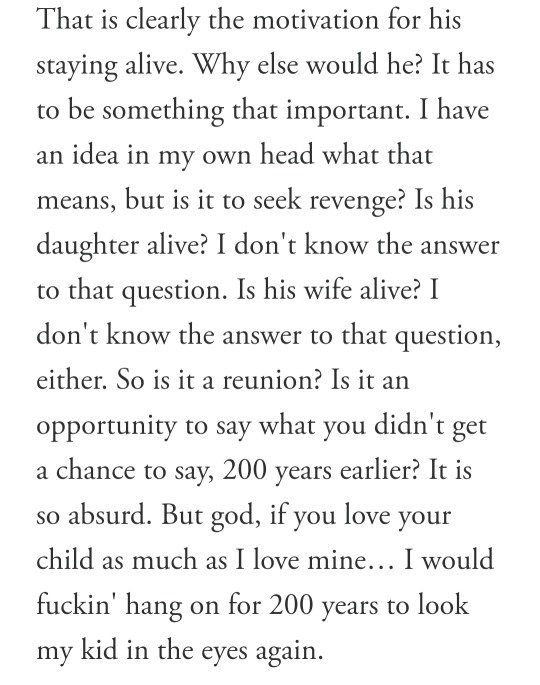

728 notes
·
View notes
Text
Can we talk about this scene again?

Barb pitches the taffy to Cooper, while she knows he's gonna hate the taste. And when you look closely at her face, it becomes clear she is manipulating Cooper, preparing the ground for what she wants him to do, while she knows he isn't the kind of man to like working for an evil corporation. There are glimpses of both uncertainty and resoluteness on her face when she flirtingly talks about the taffy.
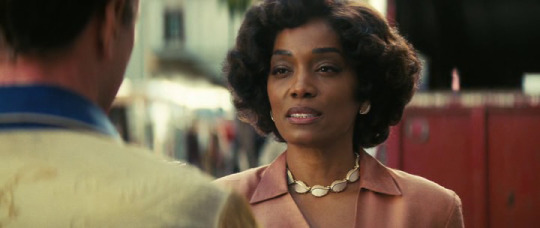
I bet nobody would have paid any attention to the way Cooper touched her hand with the very finger that Lucy bit off later if Barb hadn't emphatically spoken about "someone touching you for the first time". And Cooper just says, "May I?" and lets his finger slide along her hand. He's taken in, hook, line and sinker, by her charm, he would do anything for her.
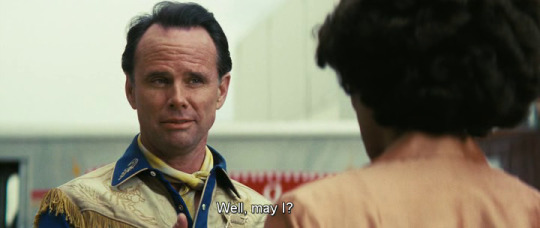
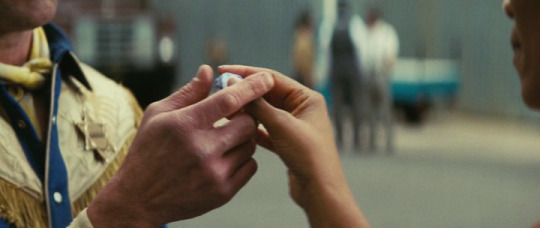
Skip forward to the present day when he's looking for Wilzig's head and sees Lucy sitting at the bank of the river. Note how beautiful the scenery is, blue water and lush green vegetation, it’s almost romantic. And when Lucy turns to him she - what? She gives him a friendly hello and a most charming smile. Even my heart melted when I saw it.
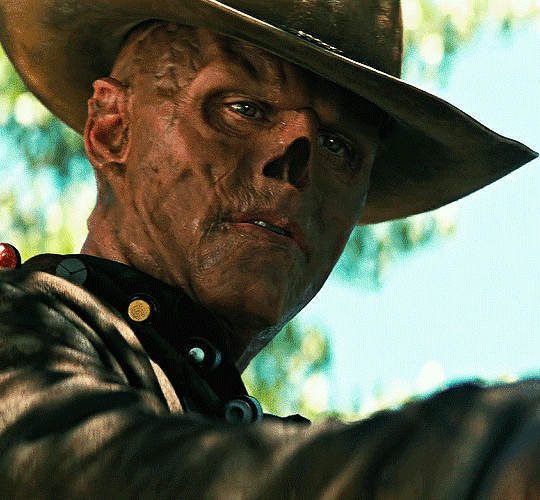
But Cooper knows better this time. Instead of going along with her being all nice and flirty, he strikes her down. He may be harsh but he doesn't let himself be dragged into another dishonest exchange. Not anymore.
#this was the reason he hit her#it's the brutal honesty of his relationship with Lucy that I find most appealing#ghoulcy#lucy x cooper#cooper howard#lucy maclean#fallout tv series#fallout prime#fallout meta#fallout amazon#vaultghoul#fallout on prime
590 notes
·
View notes
Text
Can we talk about how beautifully Lucy's character represents someone picking up Fallout for the first time?
She has all the perks she thinks she needs to have and is prepared as she thinks she needs to be until she barely survives her first fight against a raider. Dr. Siggi tells her if she insists upon being here, she must adapt. Lucy tells The Ghoul "I won't ever be like you" but has no idea what he had to do (or what she will need to do) to survive. She wants to be kind and fair to solve problems but utterly fails speech checks. She gets lost in side quests. She's shocked to learn her privilege when she sees a family of skeletons sat around a table who took poison together, and is forced to encounter it again when she says the "I recognize my privilege" line to Ma June and Ma June rejects her for it - getting by in the Wasteland is a life hard lived, one she can't understand.
And in the end she encounters a painful truth she couldn't have imagined. She finds what she's looking for and it's all fucked up. And her last move is still choosing kindness. She is faced with some bullshit "choose between two factions" decision that feels like it has no meaning in the face of war and cruelty. But when one door closes for her, another door opens for The Ghoul. So she chooses to follow him; to give back instead of take. And the world moves on. There's a billion more quests to follow. Lucy isn't done with the Wasteland yet, and the Wasteland is not yet done teaching her the game.
#I've said what I've said about how people are acting/reacting and I'm gonna focus on what I like instead of what others are saying/doing :)#fallout show#fallout#fallout amazon#lucy maclean#the ghoul#fallout meta
878 notes
·
View notes
Text
I think Piper Wright Fallout 4 is one of those characters who's good in theory but not in practice. I was thinking about her as a character in relation to her setting and I genuinely think her archetype would be better suited to the NCR than it is to the Commonwealth.
Which I think comes down to how Bethesda handles their games, environment and attitude wise, as opposed to Black Isle and Obsidian. The West coast has basically recovered. New Vegas is a tourist attraction. The NCR are on a rapid tirade of imperialist expansion that's only achievable because they, as a nation, have recovered from the war and grown from it. If you compare Shady Sands in Fallout 1 to Diamond City in Fallout 4, its kind of funny. Shady Sands started out with decent houses made from dirt, with solid foundation and some of them having actual windows. The average settlement in Bethesda Fallout (like Diamond City or Megaton), meanwhile, are just shanty towns made from tin.
In the Commonwealth's case this is made even more insane by the fact that Fenway Park (where Diamond City is located) is surrounded by mostly intact houses that, with a bit of fixer-uppering, could be lived in relatively normally compared to the tin shacks of Diamond City. I think Megaton gets more of a pass because the Capital Wasteland got nuked to shit, but you get me.
Returning to Piper for a second, let's take a look at her character: she's a spunky, somewhat annoying character who's very invested in the freedom of the press and so forth. She's got a working printing press and everything, which is super impressive considering how run-down the rest of Diamond City is aside from the Valentine Detective Agency signs (seriously, where did they find the materials for those). She runs Publick Occurences solo with her sister, and it's all well and good. Ignoring the witch hunts she sends people on about synths.
And I get it. I think this specific gripe with Piper as a character comes from having played this game for the first time in 2024. The synths don't really hold up as an allegory for anything, and the entire story surrounding them is very "trying to be progressive in 2014". Which is fine, I think it is just a symptom of the era the game came out in, but still.
Piper's character, as a spunky yet annoying journalist who believes the people deserve to know what's going on, would be far better suited in a more developed location on the West coast -- specifically, Freeside or somewhere within the NCR.
I think Piper would suit the Followers of the Apocalypse, for example, serving as an informant to keep them in the know about what's going on between the Strip, the NCR and the regular Freesiders. Plus, having a funny, anarchist-themed newspaper you can receive in-game where she touts her hatred for the Securitron police force is a funny mental image. Equally, I think she'd suit living in Shady Sands -- right at the heart of the NCR's seediest political manouvres as the decisions are made. Imagine her as a journalist who frequently pushes back against the Mojave expansion, for example, and how the NCR is putting too many resources into a lost cause instead of more important things like healthcare or housing. That way, you could still keep her extreme hatred for the upper class in The Stands while making it make more sense within the setting.
Leading on from this, this made me realise how Bethesda also just aren't very deliberate with how they utilise history in their games. Which makes sense, to a certain extent, given how destroyed absolutely everything on the East coast is. But still. It's a little stupid.
The core conflict of New Vegas -- the Legion vs the NCR -- is actually a really deep-cut history reference at its core. The NCR is the Bear, the Legion is the Bull. In mid-19th century California, people watched bears and bulls fight for fun.

There are other, better examples, I'm sure. But I'm British and this is my personal favourite example, so this is what I'm using. History plays such an important part of New Vegas' themes and messaging -- it's a story about how, when, and why humanity needs to move on from the past and look towards the future.
Bethesda Fallout, by comparison, will frequently and shallowly tout "nukes bad" while letting Liberty Prime lob them at Super Mutants, or encouraging players to nuke each other's houses in Fallout 76.
Piper exists partially as a nod to the Boston Herald, and how it's one of the longest-running/most influential newspapers in America. A lot of publishing has its roots within Boston, and I think it's an interesting reference to take.
And I think this is a part of Fallout that Bethesda does get -- a lot of what people do in the post-war world is inspired by what came before. Caesar's Legion and its ideologies come from Edward Sallow not understanding basic Roman history properly and using it to fuel his agenda because it looks cool. The Minutemen are exactly that. The New California Republic are the new US government, right down to the borderline facist intentions and ideologies. I could go on.
And this comes from Fallout being a series about the cyclical nature of violence. "War never changes, but men do through the roads they walk" is the story here. War cannot change if men do not change, because war exists in an endless cycle of violence that can only be broken if man chooses to break it. And they've failed at it so far, right?
And this is where I go back to Piper. Her nod to history isn't as intentional as anything in New Vegas, and I feel like she would have been better served as a character if she was in New Vegas instead. Because her entire character would make more sense if she was living in the more developed and rebuilt towns of the West coast as opposed to a dilapidated shanty town on the East.
I have more thoughts about this but tl;dr Bethesda should really put more effort into making sure their history references and homages make sense to the setting contextually, in the same way that New Vegas does. That game was developed in 18 months and still has far more care put into its historical references than Fallout 4 does. And I love Fallout 4.
#fallout#fallout 4#fallout new vegas#piper wright#fallout meta#fallout 76#FNV#fo4#fo76#piper fallout 4#I wrote this in one go and only barely proofread it so I hope this makes more sense than my last attempt at a fallout meta post
157 notes
·
View notes
Text
Real talk, I came to the Fallout series a total newb, knowing nothing about the lore/games and came away with a new favorite show, easily in my top five. In particular, something it does exceptionally well is narrative payoff. Nothing in this show happens just to happen; every choice the characters make shapes their future arcs. As a SFF writer myself, I'm not only impressed--I'm inspired.
I feel this way about the entire story, but in terms of Lucy and Cooper specifically, we get so many great payoffs from their interactions. When he doesn't share his water, it seems like he's just being a dick until we learn that his canteen is full of dirty water. (Yes, he was still being a dick, but he knew she naively thought he was drinking clean water.) When he forces her to use the knife in the "ass jerky" scene, he's absolutely being cruel, but he's also extremely fatigued to the point of near collapse, which only becomes clear only after she's out of sight at the Super Duper Mart. When he cuts off her finger, it seems like nothing more than him "getting even," when he actually took a much-needed replacement part for his hand (from someone he assumed wouldn't be alive much longer).
These interactions are all brutal, give us new insights into both characters, and also set up a massive payoff in Lucy's "golden rule, motherfucker" moment. Even after everything he put her through and how he treated her as disposable, she does the opposite and shows him empathy and kindness. To put it plainly: Her choice in this scene wouldn't carry half as much weight if he hadn't repeatedly treated her like shit. Coupled with her ability to self-rescue, the scene cements who Lucy is as a person--both for the viewer and for Cooper. (And what happens next? He watches a film clip where his old self looks right at him and delivers the line about a villain being ugly and strong but having no dignity.)
The moment when Lucy gives him the vials could have been enough of a payoff for their arc by itself. But it sets up an even better one: The next time they cross paths, he treats her differently. Having already seen himself in her, and knowing that they both want answers to the same (or very similar) questions, he invites her to accompany him on his journey this time--no longer as a pawn, but as someone he trusts and respects at least a little. As a direct payoff for her memorable act of kindness toward him, this fucking rules. It's surprising while also feeling completely earned. "Golden rule, motherfucker," isn't just a satisfying moment (or my favorite line), it shapes the characters' future.
On Lucy's side, when she decides to follow him, she has no reasons to trust or respect him (yet); she likely just recognizes that he's currently the only person who will lead her to the truth. But she's only met the Ghoul so far, not Cooper Howard. She doesn't know that his primary motivation has been searching for his family this whole time. She doesn't know that she's seen him before, in those old movies she watched at home. She doesn't know why he shot the billboard.
Now, I'm not making predictions about how their future arc will play out (nor am I asking for them), I'm just along for the ride. But I feel confident that there will be many more great payoffs to come now that they've gone from "hostile forced proximity" to "traveling together by choice." I've rarely been so pumped for a second season. <3
230 notes
·
View notes
Text
"The End" and "The Beginning"
It's interesting to notice that the first episode of Fallout is called "The End" and the last episode of season 1 is called "The Beginning". But that's because there are a lot of hidden meanings.
"The End":
The reason this episode has this name is because it specifically refers to the big moments going on in Lucy's and the Ghoul's lives.
The "End" of Cooper Howard:
We open on October 23, 2077, with Cooper Howard performing for a kid's birthday party. During the party, the Great War breaks out as the bombs fall on America. This marks the fall of America.
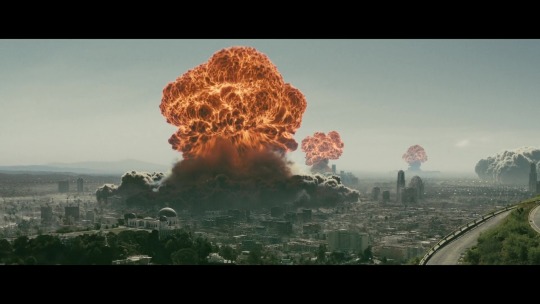
But it also marks the "end" of Cooper Howard. Because the last we see of Cooper, he's riding away on Sugarfoot with Janey as the bombs fall. When we next see him, he's the Ghoul, and he's very much suppressed any attachment to the identity of Cooper Howard. He wears a tattered jacket and a bandolier over his old movie costume, and he's pretty much done everything to disassociate himself from his old identity, right down to using the Southern accent he used in his movies as his main accent.
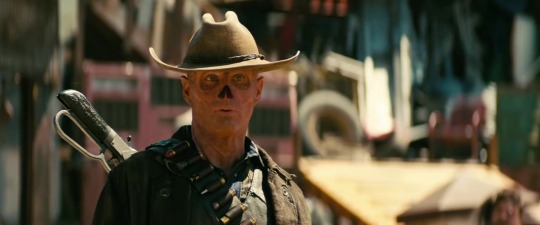

The "End" of Lucy MacLean the Vault Dweller:
The episode being titled "The End" also fits the fact that we're seeing the final days of Lucy's life as a naive Vault Dweller. After all, a common theme amongst the Fallout games where the player character starts in a Vault is that you're irreversibly changed when you set out into the Wasteland.
And for Lucy, this moment where she passes through the vault door might as well be a metaphorical "death" scene, as demonstrated by how the blown out lighting makes it look like she's stepping "into the light".

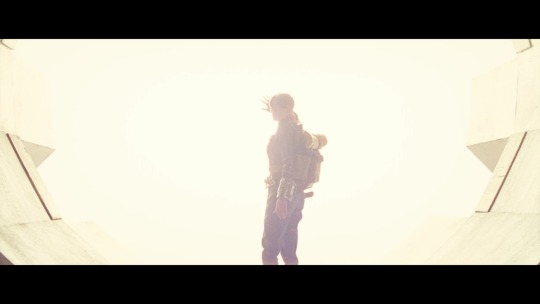
"The Beginning":
This episode's title is also about pivotal moments for Lucy and the Ghoul, but also a few others.
The Beginning of the Great War:


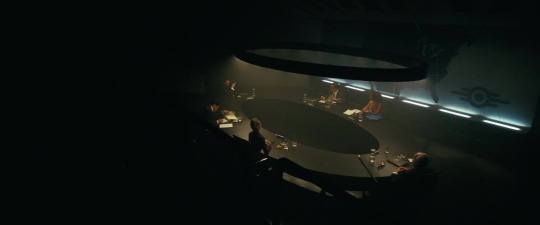
This one's technically a bonus. But this episode is where we get to see the exact moment the Great War actually began: in a dimly lit room where Barb and other collaborators from Vault-Tec and other big corporations met.
The New Beginning of Cooper Howard:
Over the episodes that follow the Ghoul's little misadventure with Lucy, we see that her refusal to break despite his efforts to bring her down to his level have instead had the effect of helping him rediscover his old morals.
Here's the notable things the Ghoul does between the Super Duper Mart and when he meets Lucy again:
He takes the heat for Lucy's killing of the organ harvesters and some of the feral ghouls under questioning from Sorrel Booker.
He re-adopts CX404 and renames her Dogmeat, something that's intercut with flashbacks of him with Roosevelt, his pre-War Border Collie.
He shows sympathy for Lucy over her feeling betrayed by her dad, given he went through the same thing.
But the most telling clue that Cooper Howard has found a new beginning is the fact that his last line of the season is said in his own accent, not the Southern twang he's used as the Ghoul or in his movies:

The Beginning of Lucy MacLean the Wastelander:
A common thing we've seen across the Fallout games is that Vault Dwellers who leave their vaults can never go back.
The Vault Dweller from Fallout 1 gets banished from his Vault due to having been radically changed by his experiences in the Wasteland.
The Lone Wanderer of Fallout 3 fled into the Wasteland after nearly being killed by the Overseer. But they can't go back to the Vault for the sake of maintaining piece there following a civil war.
Lucy continues this grand tradition.
When she left Vault 33, she only went out with the intention of rescuing her dad and returning with him to the Vault. But as Wilzig warns her, she'll change, whether she wanted to or not.
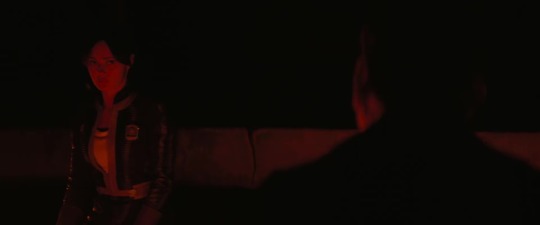
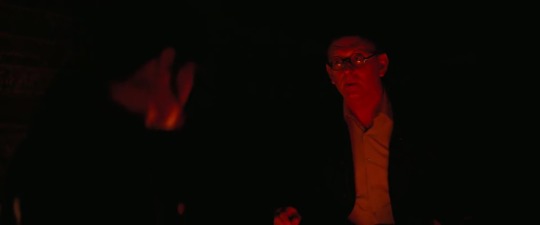
Wilzig: You come from a world of rules, of laws. This place is indifferent to all of that. I do not think you would be willing to do what it takes to survive up here. Lucy: I'm not going back without my dad. Wilzig: If you insist on staying, then you will have to adapt. Question is will you still want the same things... when you have become a different animal altogether?
We see that Lucy does change. She becomes more jaded, cynical, violent, and less trusting of others, though she refuses to compromise her morals.

But once she gets to Moldaver, she ends up learning that all these things she was forced to endure these past two weeks were done on false pretenses: her dad's no saint at all. He's a war criminal responsible for the deaths of over 30,000 people out of petty jealousy because his wife dared to take Lucy and Norm away from him to live on the surface.


She can no longer recognize the man she once idolized and called her dad, because he was never real. She can no longer recognize herself as 'Lucy MacLean, Dutiful Vault Dweller" because that girl died when she stepped out of Vault 33. Her whole life has been nothing but lies.
And that feeling is only reinforced by what the Ghoul says: "You want to know how I know your daddy, don't you? Let's just say that everything about your whole little world was decided over 200 years ago." And while the Ghoul continues talking and tells her that she'll be killed by the Brotherhood if she sticks around, he's blurred out, visually conveying that Lucy has tuned him out and her inquisitive mind is stuck on the last sentence.


She wants answers, and the one who can help her find them is the man who pistol-whipped her, used her as bait for a Gulper, cut off her finger, and sold her organ harvesters.
She can't go back to Vault 33 again. Maybe she returns to rescue Norm and Chet, but there's no way she can ever live there again.


So she does the only thing she can do in this situation: she puts her mom out of her misery, and embraces the identity of "Lucy MacLean, Wastelander".

Ella Purnell said it best: "By killing her mum in a mercy kill, she’s doing exactly what the Ghoul did to Roger [in episode four]. She’s learnt from him. She has turned into him. When she said, “I’ll never be you,” maybe that’s not true. And in that moment, when she shoots her mum, it means so many things. It means, ‘I’m coming with you.’ It means, ‘I’m gonna meet my makers.’ It means, ‘I fucking hate you, but I have turned into you, you were right.’ It means she’s letting go of her golden centre."
The Beginning of Lucy and the Ghoul's partnership:
And of course, "The Beginning" is the start of Lucy and Cooper Howard's partnership.
It's a big shift for them to have gone from Lucy being his hostage...


...to her being his traveling companion.


Now it can truly be a mentor-mentee relationship where they bring each other to a sort of middle level, where Cooper softens and rediscovers his old ideals while Lucy hardens without compromising her morals.
I think Ella Purnell and Walton Goggins described this best in Variety's interview about shooting the Griffith Observatory finale (skip to 17:55):
youtube
Purnell’s lightbulb moment hit when she realized it all came back to the Ghoul. “Part of the Wasteland that I carry with me literally is, it’s not the Wasteland; it’s the Ghoul. I’ve turned into him when I said I wasn’t going to do that,” says Purnell. “Most of Lucy hates herself for what she’s turned into, hates him for what he’s turned her into. But she doesn’t have a choice. She can’t stay here. When he says, ‘Do you want to go meet your makers?’ Lucy is never going to say no to that. And so, it’s not a broken ‘okie-dokie.’ It’s an acceptance of what’s happened to her. It’s an, ‘OK, there’s nothing else for me to do except put one foot in front of the other.’” Goggins says the scene was one of the “most fulfilling parts” of the project since it started so brutally and ended slightly softer but not overly sentimental. The actor is glad the co-creators didn’t lean into that sentimentality. “It isn’t father-daughter,” he says. “I think it is a person who has seen the loss of innocence in another person and deeply empathizes with it because he himself went through a similar experience 200 years earlier and is still reeling from the loss of that innocence that his tone changes. And when he says, ‘Are you coming?’ I just think that’s a pretty cool way to go out.”
#fallout meta#fallout tv series#fallout season 1#fallout season 2#lucy maclean#cooper howard#the ghoul#ella purnell#walton goggins#fallout prime#ghoulcy#barb howard#bud askins#hank maclean#lee moldaver#vault-tec#vault tec#vault boy#Youtube
117 notes
·
View notes
Text
From Gloves to Fingers: The Ghoul and Lucy MacLean
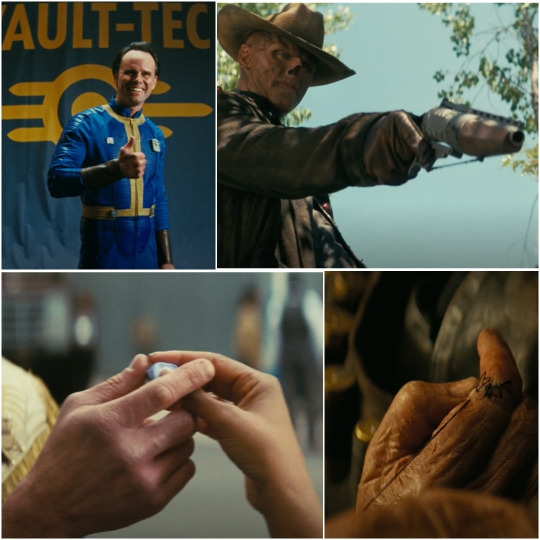
Despite their mostly practical usage nowadays, gloves used to be a powerful tool in society. There were rules about how and when a person should wear them, and what messages they relayed to others. Gloves were more than a fashion accessory; they had symbolic functions. Across various sources, such as visual media, art, and literature, gloves are associated with notions about power, protection, purity, as well as sexuality.
In the following analysis, I will examine the Ghoul’s gloves in Fallout (2024) as a visual key to understanding his character, motivations, and relationship with Lucy.
What if I told you that the first thing we see about the Ghoul, his introduction to us, is his gloved hand?
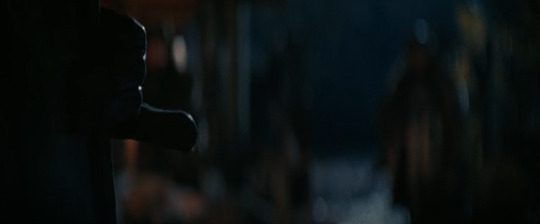
His character is shrouded in mystery, and his gloves facilitate this impression. When a character hides their hands, we assume they have secret or evil intentions. That’s why gloves have come to be associated with villains. And at first glance at this character, this assumption would not be far from the truth. But in the Ghoul’s case, it’s more complicated than that. Let’s roll back to the beginning!
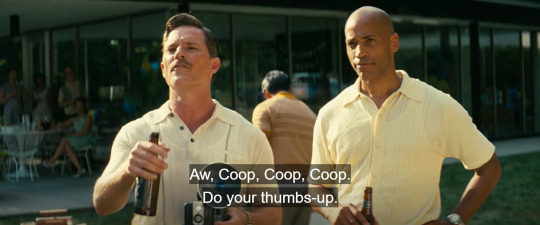
As soon as we learn that the Ghoul used to be the famous Hollywood actor Cooper Howard, and the face of Vault-Tec, we start to make the connections. For instance, we know he refuses to do the thumbs-up for the photo during the birthday party. The thumbs-up, his thumbs-up in particular, is a symbol for Vault-Tec, a company he has grown to despise. So it isn’t surprising that he would try to conceal his relation to the company, figuratively and physically.
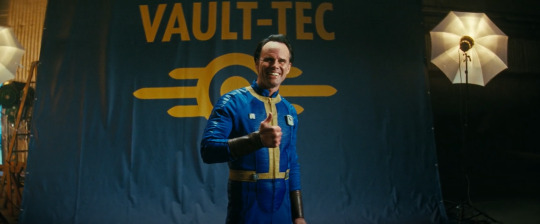
Two hundred years later, we learn about the nature of ghouls. Radiation has ravaged their skin and appearance. In this case, the gloves might serve the cosmetic purpose of hiding most of his scarred body.
However, it all comes down to the image he presents to the world around him. His gloves, and his hat, are accessories for the costume he’s chosen to wear. He doesn’t go around by the name of Cooper Howard anymore; he has built himself a new identity, using props just like an actor would. He is recognizable by these attributes and they are a makeshift armor for the real man underneath it. I’d even argue that his gloves act as a physical and psychological shield between him and the atrocities he’d committed to survive.
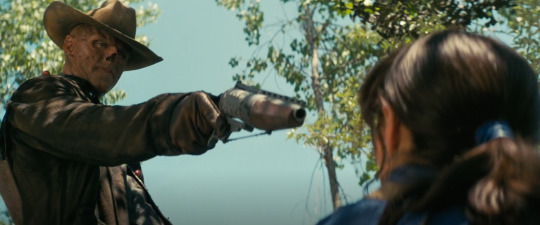
Now that we’ve discussed the symbolism of him wearing gloves, it’s time to ask the important question. Do we see the Ghoul’s ungloved hands? We do. Two times. And both of them are connected to Lucy: one in her presence, one in the presence of her finger.
The first time we see the Ghoul’s ungloved hands is after the significant scene of him mercy killing Roger and feeding on him in front of Lucy. The fact that Lucy witnessed him eat, not just any food but human flesh, is extremely important. In that scene, he reveals his animalistic nature. It’s an intimate scene because he begins her initiation into the Wasteland by offering her his knife to cut off some pieces herself. In a way, he shares his meal with her. Her repulsion is clear but she relents. It’s important to keep this scene in mind.
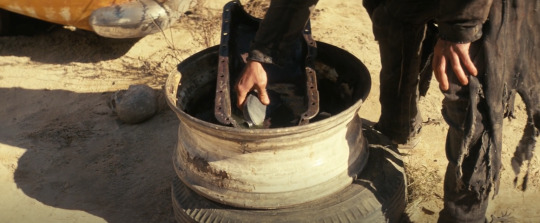
Cut to the scene with him with no gloves. At this point, he’s shown her a part of himself. In the past, the removal of gloves was a sign of closeness, and even inferiority. He has shed his skin, literally in the form of his gloves. He has allowed himself to be vulnerable in her presence. He’s naked in a way we haven’t seen before. It’s no wonder what happens next has so many sexual undertones.
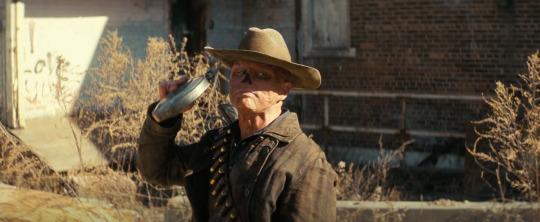
To put it plainly, in this scene we see the Ghoul relishing the taste of irradiated water while Lucy is right next to him… thirsty. It’s an interesting juxtaposition to a previous scene when Lucy politely asked for water but he denied her (with his gloves on, retaining a metaphorical barrier, an air of superiority). She then saw the pool of water but resisted drinking from it while he taunted her. Now, it seems different. He watches her with a silent challenge in his eyes, tempting. She isn’t asking him anything this time. All she sees is the water, the means to quench her thirst, and… his ungloved hand.
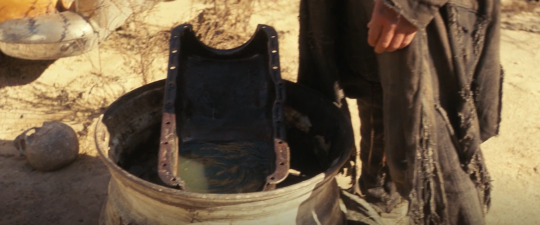
Personally, I find the choice to include his hand here very interesting. What happens next, even more so; Lucy succumbs to her thirst. In contrast to her hesitation and revulsion with slicing pieces off Roger for food, she eagerly drinks the irradiated water the Ghoul drank moments ago. It’s a desperate physical need, and it’s out of her own volition. If you don’t see anything sexual about this frame, I don’t know what to tell you:
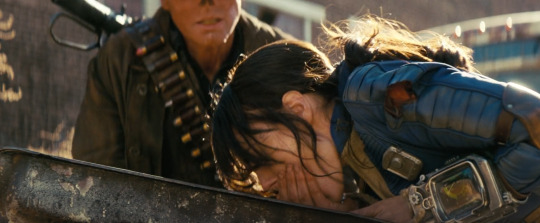
It’s worth mentioning the way the Ghoul stoops to her level here which enables the iconic “Oh, I’m you, sweetie.” She’s almost his equal here, as they stare after she’s drunk the water, their hands ungloved.
Lucy, being ever the opportunist, sees his weakness and tries to run away. Her attempt is short-lived because he catches her in his lasso. And all the build-up ends in one of the most memorable scenes in the show; and for a good reason!
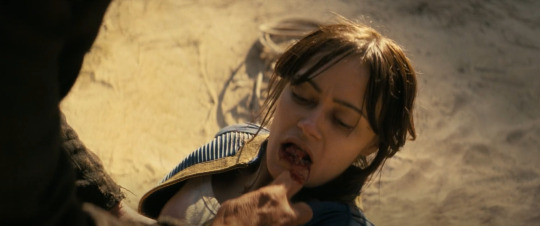
In their struggle, Lucy takes advantage of his exposed hand, his weakness, and bites his finger off. It’s almost like she’s turned into him: an animal tearing flesh. The gloves would have protected him against harm but he’s taken them off, he has allowed himself to be vulnerable around her. Perhaps, he underestimated her.
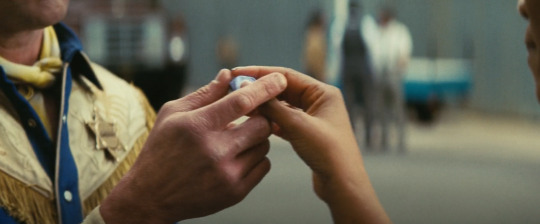
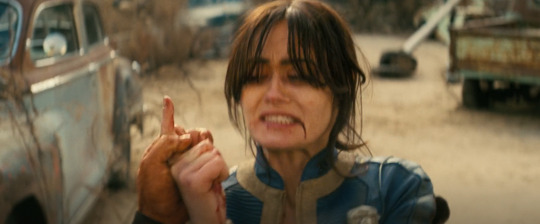
In a violent imitation of a lover's touch, he cuts her finger off. This is the first time they touch hands. In the past, a woman had to be wary of a man’s ungloved hand because it signified danger and the loss of her chastity.
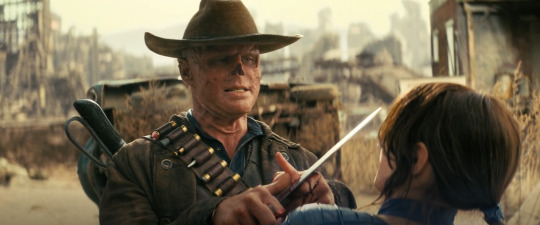
In Lucy's case, chastity refers to her naivety about navigating the world around her. The Ghoul opened her eyes about the surrounding world, but she dared to go one step further and stole something of his, a part of him. For two centuries, he's managed to keep his ten fingers intact, a sign of his competence, and it's none other than Lucy who overpowers him this way. So he feels obliged to take a part of her to replace his missing one. It's very much an exchange of rings/vows type of situation. But I digress.
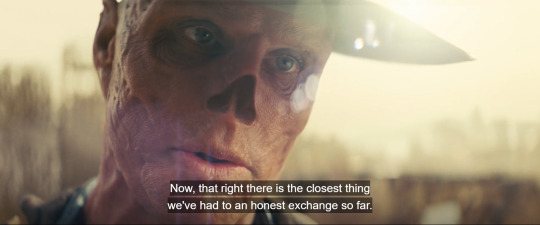
After the finger exchange and the visual replacement of Lucy's finger, which for a second looked to me like adding a band/ring, we see the most significant scene for her character yet. She survives alone in the Super Duper Mart and despite it all, retains her principles, by saving his life. She emerges the victor, both in terms of survival and morals. But how does the exchange affect him?
In a rare scene of self-reflection, the Ghoul watches his old human self on film. The gloves are back on and he mimics pulling the trigger, nothing unusual.
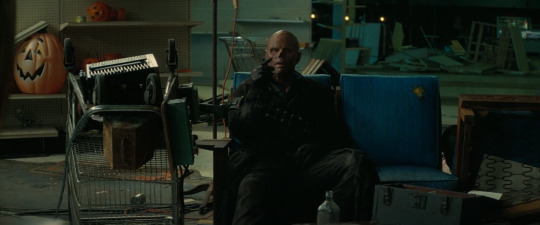
But as we watch him rub the leather of his missing finger, we know that something has shifted. Beneath the seemingly intact glove, there is a missing piece. Try as he might to conceal it, and even if it's unnoticeable to others, he’s aware of its absence. Despite the external armor, the damage is internal.
Which brings us to the second scene with his ungloved hands: the scene of him sewing Lucy’s finger on his hand.
The Ghoul is held responsible for the thrashing of the Super Duper Mart. While they question him, he asks for the needle and thread (red thread of fate, anybody?) in his bag. As he unrolls the piece of cloth, we see Lucy’s finger.
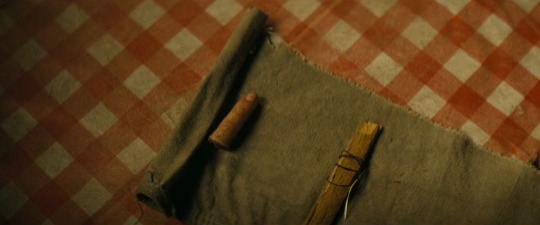
Here I want to make an important note: In the past, gloves were considered an extension of the wearer’s body; another symbolic body part. In the classic novel Little Women, Meg loses one of her gloves and it turns out that the man who is interested in her romantically – Mr. Brooke – has hidden it in his pocket. Later, characters would consider this act a declaration of his intentions toward her. The Ghoul has neatly packed away Lucy’s finger in his bag. The subtext is definitely there.
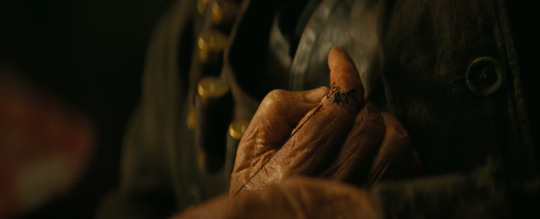
In the first scene when he was ungloved, it was in Lucy’s active presence. In this scene, she’s not here but her presence is felt, and not only because it’s her finger he’s sewing. While he is attaching the finger, he takes the blame for what she did in the Super Duper Mart. He throws away the act for a moment, his hands are ungloved and unprotected, as he surrenders himself in her name. The intimacy of the mere image of him sewing a part of Lucy’s body on his own, literally tying the knot, deserves its own analysis.
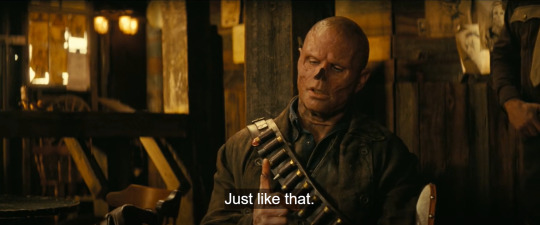
You could say it fits him like a glove. ;)
This is the last scene we see him without gloves in S1. But every time we see his gloved hand afterward, we are reminded that he carries Lucy’s finger. It’s a symbol of what Lucy reminded him of: his lost dignity. It’s his trigger finger, a moral compass. It led to him shooting her dad when she herself wavered, but also letting him go alive. And it’s her replaced necrotic finger which pulls the trigger when she mercy kills her mother, a lesson she learned from him. Their fates have intertwined and their fingers are the perfect representation of that.
With the focus on hands and fingers we saw in S1, I expect this symbolic storytelling to continue and expand in S2.
197 notes
·
View notes
Text
We talk a lot about him seeing his old self in Lucy, and their journeys mirroring each other, but let's talk about the function of dogs in relation to Cooper and the Ghoul.
Dogs are an important way of showing the Ghoul's humanity
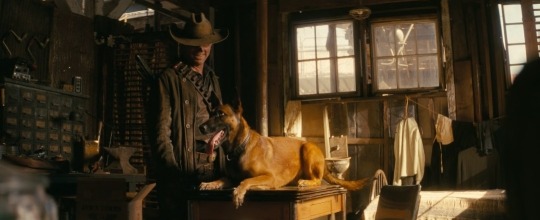
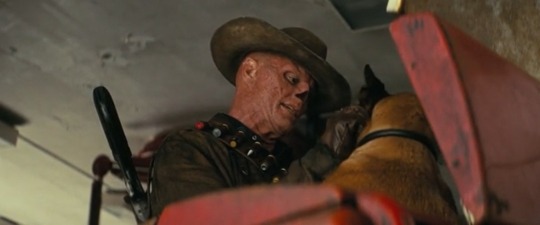
Seeing how one of the things that got human Cooper to change his mind about listening in on his wife we know how deeply he cared for his dog
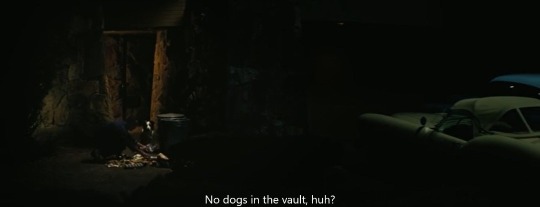
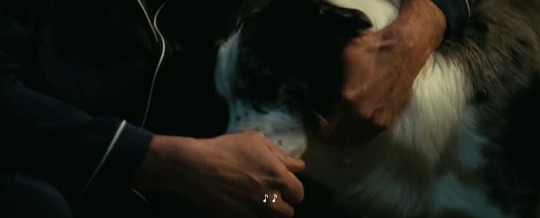
Dogmeat may not be the same dog
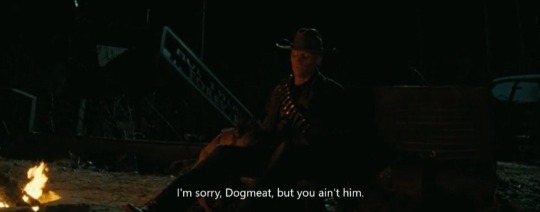
But through him we see glimpses of his humanity
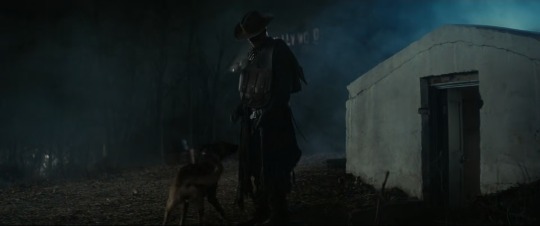
Because even after the dog's usefulness has run out (tracking the head is no longer needed) he STILL keeps him around. And damn, if that ain't proof there's a heart in there I don't know what is.
#fallout#the ghoul#cooper howard#fallout ghoul#fallout meta#fallout tv series#feel free to add on cause there's a lot more I dont have the energy to write
254 notes
·
View notes
Text
Playing Fallout 4 on survival difficulty is interesting in that it makes the story significantly better through emergent gameplay. It took me roughly two in-game weeks of scavenging and scrounging every available resource before I was able to get out of Sanctuary alive. My first human contact was with a raider at an unmarked hovel north of the island who sicced a German Shepard on me without warning, and then nothing until Concord. I lost two shootouts with the bloatflies by the bridge. Fighting my way south to Diamond City was a jumpy, touch-and-go odyssey, and I was stuck in Diamond City for easily another three in-game weeks scraping together the resources necessary to punch through to Park Street station. Rinse and repeat for going after Kellogg, for punching through to Goodneighbor, for punching through the glowing sea to find Virgil. I actually had to plan shit out! For everything!
An inability to fast travel and a protagonist made of tissue paper turns every paperthin "moral compromise" present in the base game into a genuine nailbiter simply because you don't have the typical assurance that you'll be able to survive pursuing the dudley-do-right option. Covenant is a pointed example of this; attempting to take a stand against their kidnapping program is genuinely dangerous and impactful in a way it isn't in the base game, since you do it from within the belly of the beast and it converts a badly-needed stopover point into an inconveniently positioned, hard-to-assault nest of gunmen out for your blood. Extensive settlement building with the Minutemen goes from a bizarre, dissonant digression from the significantly more pressing business of finding your son, to a forward-thinking and practical measure taken to facilitate living long enough to find your son. The Brotherhood might be incipient technofeudalists but fuck it if they don't provide on-call airlifts. The Institute might be a totalitarian technocracy with a slave-based internal economy but they've got teleporters, running water, and if you threw in with them you'd never have to deal with any of this bullshit on the surface ever again. All of that's true in the base game, from a thematic perspective, but Survival mode makes you feel it. Finally, I understand the convention of NPCs farming out even the most basic fetch quests to the player; you're experiencing what the narrative has always been claiming would happen if they tried to do any of this themselves.
617 notes
·
View notes
Text
FOTV'S PLOT MAKES NO SENSE
So since this is going to have MASSIVE spoilers for the new show, I'll put most of it behind a readmore. But, TL/DR: Destroying Shady Sands would not bring down the NCR, because they have at least seven other major cities that could and would take over!
So, lets start with a map:
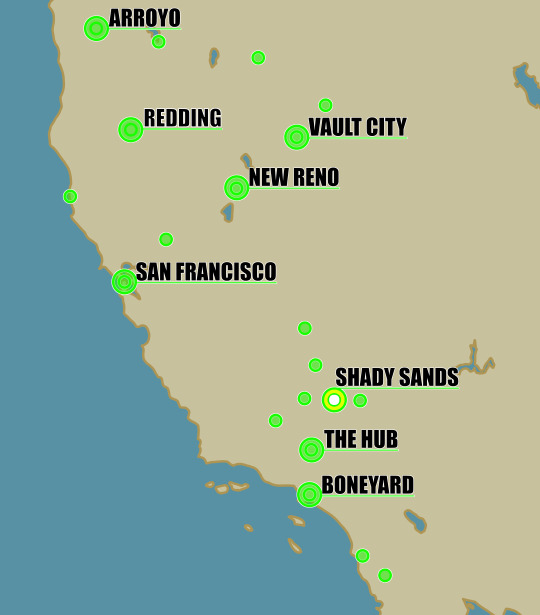
This is map (made by me) very roughly represents the NCR as it exist circa 2277. All major settlements are labelled, but do note that there are dozens of minor settlements scattered around the whole of California, and into Oregon, Nevada, and Mexico.
Nuking Shady Sands, even if you used the largest nuclear bomb ever made, (The Tsar bomb: coming in at 100 megatons, it is the upper limit of practicality for a bomb, because any larger and the explosion would've vented into the upper atmosphere and reduced the bomb's effect), it would still only destroy Shady Sands. Maybe vaults 13 and 15, the closest settlements to it (given their nature as vaults, however, I think they'd survive).
Notice all the other settlements? WHERE DID THEY GO, TODD?
Now, exploding Shady Sands would still be really fucking bad for the republic, but I think it would be fully survivable. We don't have hard numbers for the population of the NCR, but in New Vegas it is explicitly in the hundreds of thousands, (and rising). So we can substitute the demographics of, say, Alaska (710,000 people). The largest city in Alaska, Anchorage, has ~290,000 people living in it, as of the 2020 census. That's a large chunk of the state's population, but its not even half.
I think Shady Sands would probably be a lot smaller than the Hub or Boneyard (not to mention San Francisco, Vault City, or New Reno) because it started out as a small farming village when the others were already major settlements. So, at most, nuking Shady Sands would only disrupt the NCR, not kill it. Even if the NCR broke up in the aftermath, Lucy's vault should still be smack in the middle of the Boneyard, probably one of California's largest settlements.
But! That's not all! Not only does this show contradict established canon at every turn, it doesn't even do it well, because there is an argument to be made that a few well placed nukes could bring down the NCR!
And its already part of the damn game:

This handsome, gravelly-voiced genius already mathed out how to, as he calls it, "cut the bear's throat": bomb the NCR's trade routes to the outside world, and watch them wither away on their own. His plan is a thousand times more interesting, and more feasible, than how the show brought down the NCR (blowing up one (1) city and acting like that would destroy an entire nation).
In fact, if they really wanted to get rid of the NCR, they could've easily just made that ending to Lonesome Road canon. But, lets face it, this show cannot be bothered to even look at the games for inspiration.
I like almost nothing I see coming out of the show. Its a thin veneer of fallout painted onto a story that bulldozes the very series it claims to be part of. The zombification of ghouls, the centering of the Brotherhood, the badly written raiders playground of a wasteland: its all of Bethesda's worst writing choices, just transmitted to a new medium.
I hate it here.
#fallout show spoilers#fallout meta#fallout amazon prime#fallout new vegas#If you liked the show I don't hate you. I just wish they hadn't made the show overwrite west coast canon for Todd's petty vendetta#The show pisses on half the entries in the series because Todd can't stand people liking them more than his loot'n'shoot slop.#I don't even like the NCR. They're an imperialist capitalist hellhole. But they deserved a better story than this bullshit#Honestly if they had just placed the show in like. Montana. it would've been fine. They didn't have to break the setting for it#Anyway if you love the show and haven't played the games: please play fallout New Vegas. Its a good game.#If you come at me with 'you just hate fallout 4' I actually really liked 4! I think about it a lot! Its what got me into this fandom!
156 notes
·
View notes
Text
#tumblr polls#poll#polls#fallout new vegas#fallout oc#fallout 4#fallout 3#fallout 76#fallout wiki#fallout poll#fallout shitpost#fallout fandom#fallout games#fallout headcanons#fallout lore#fallout memes#fallout community#fallout meta
450 notes
·
View notes
Text
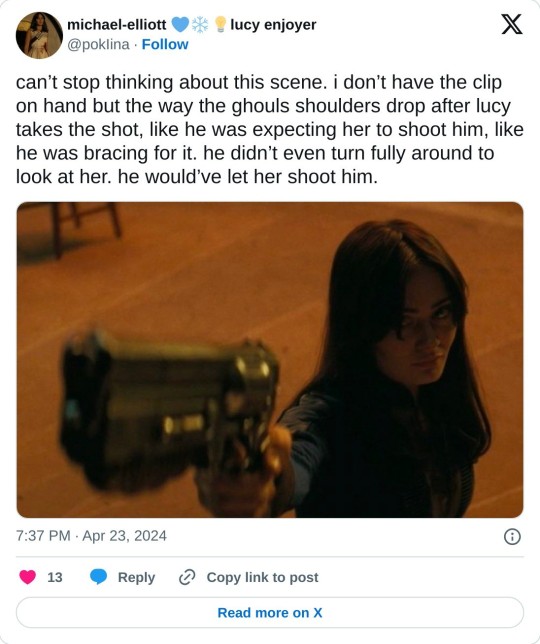
Giving her his back was acknowledging she had the right to kill him if she wanted.
That's why he made her walk out ahead with her back to him when he was being an asshole.
He reversed it by letting her have his back and the choice of what to do with him.
473 notes
·
View notes
Text
Yet another Ghoulcy parallel to relish!😃
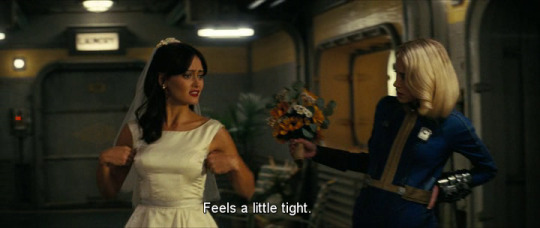
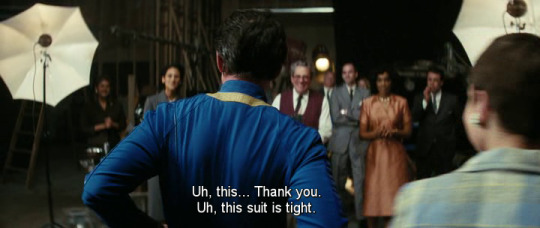
#i may not be the first one to discover it but i haven't seen it mentioned#ghoulcy#lucy x cooper#lucy maclean#cooper howard#fallout prime#fallout meta#fallout tv series#fallout amazon#vaultghoul#fallout on prime
785 notes
·
View notes